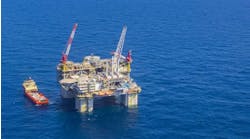Drilling has resumed off France's coasts following a decade of inactivity. Jack-up Neddrill 9 was due to spud for Hunt Petroleum in the Channel in April, nine months after Elf began its campaign in the Gulf of Gascogne.
France's Industry Ministry is not expecting a host of others to wheel in rigs, but long-term there is scope for optimism. To the north, the Western Approaches (Iroise Sea Basin) and Channel are on trend with the gasfields off south-east Ireland and BP's Wytch Farm oilfield on the English south coast.
British Gas has been drilling off the Dorset coast, and more wells are expected off south-west England following new frontier acreage awards by the UK government. Any successes could tempt more oil companies to dip their toes in the Iroise Sea.
Hunt's current exercise, expected to take up to six weeks, is the first commitment well on its Pointe de Barfleur permit awarded in September 1991. Water depth is 70 meters in an area 48 km off Normandy's Cotentin Peninsula. Future work commitments have not been revealed.
According to the Industry Ministry, no other companies have requested permits in this region, but Elf, Amerada Hess and BHP have applied jointly for the Ouessant license in the Iroise Sea. The acreage sought covers 11,700 sq km in water depths varying up to 200 meters.
When the permit is approved, a 3D seismic survey is likely to follow quickly. The Industry Ministry says high quality seismic profiles will be needed "in order to delineate subtle traps, to map the distribution of organic-rich early Liassic intervals and to evaluate the amount of erosion following the two inversion events of Apten and Oligocene age".
CGG may also be planning 1,400 km of spec 2D seismic in the Western Approaches to add to a smaller survey it shot for IFP in 1988.
Thirteen wells have been drilled in the Iroise Sea, the last performed in 1984-85. Only two broadcast positive results - small oil and gas shows in Purbeckian and Liassic to Dogger intervals. But UK analyst Wood Mackenzie says several small gas structures have been identified with potential to hold 250-400 bcf.
Biscay blanks
The Bay of Biscay is considered France's most prospective offshore region, but also the most frustrating. On the landward side of the Prentis Basin, significant oil shows have been uncovered in late Barremian limestones and early to middle Jurassic limestones. On the offshore extension, however, the Basin is thicker and plays have proven more difficult to define. This has dampened drilling enthusiasm.
Elf, though, tried its luck last summer with the Antares-3 wildcat in 50 meters of water on an area trending with Esso's onshore Parentis oilfield. The well did encounter oil, but the reservoir was probably too awkward for production to be worthwhile. Also, the location close to France's main rocket range did not favor low-cost development.
The permit for this area is likely to be relinquished next year. Elf's patience with its Mimizan Marine permit in the deeper waters west of Born Maritime may also be waning, even though it shot 373 sq km of 3D seismic with partner Agip in 1993.
Esso Rep holds an offshore permit in Biscay called Cap-Ferret Ocean. A $9 million 3D survey was shot in 1994, in the hope of proving that the Purbeckian sandstone theme on land (holding Esso's Les Arbousiers discovery) continued offshore. But activity appears to have gone quiet, with no drilling in prospect.
Hydrocarbons are proven on the Spanish side of the bay. The structurally complex Gaviota gasfield is producing for Repsol from a late Cretaceous reservoir with source rocks of possibly late Carboniferous age.
Mediterranean revival
Offshore from Marseille in the Gulf of Lion, 11 wells have been drilled without success. However, they may have been targeting the wrong areas.
The region is characterized by Synrift Oligocene basins concealed below a few thousand meters of thick Neogene strata. According to IFP's Alain Mascle, the wells were drilled on basement highs on the edge of these basins: targets were poorly defined, so the results are inconclusive.
Recent 1D modeling by IFP shows that source rocks, if present, are within an oil window at the top and a gas window at the bottom of these basins. This presumably is Elf's goal in applying for a large permit covering most of the continental shelf of the Gulf of Lion.
The acreage's extent has not been fixed as the frontier between Spanish and French waters remains undefined. However, a seismic survey could be performed this year over waters dipping down to 2,000 meters.
A few hundred kilometers to the south in Spain's Ebro delta, four small fields are producing oil trapped on paleohighs and in fractured and weathered carbonates sealed by Neogene cover a few thousand meters thick. Similar plays may remain untested in the Gulf of Lions.
Copyright 1996 Offshore. All Rights Reserved.


